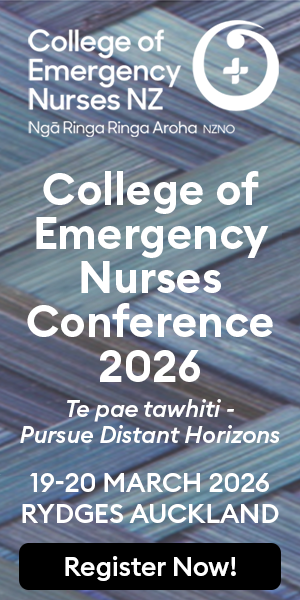
Late last year I attended my first NZNO membership committee meeting. A pervasive theme was the trauma experienced through unsafe staffing. 1 Reflected too in the media, this growing issue affects nurses and midwives in private, tertiary and community sectors, as well as those they care for.
Nurses’ history of sacrifice is well documented and continues unrelentingly. 2
Today nurses support each other and their patients by sacrificing their days off, doing double shifts, overtime – and a whole lot more. But many shifts remain unfilled even on public holidays.
There could be many reasons for this, but I believe it reflects a burned out, exhausted and understaffed nursing workforce. 3, 4, 5
This state of play was evident well before COVID-19 arrived, with predictions of 25,000 nurses needed by 2030. 6
Our members go to work every day, wondering what care-rationing decisions they will have to make, how many patients will be put at risk through unsafe staffing and lack of resources and how patients and their families will respond to the ever-increasing wait times before being seen. Yet nurses are still expected to provide safe care, despite having little control over decisions relating to nurse recruitment and retention.
Competencies for safe practice were developed by the Nursing Council in 2003. At the time, NZNO policy analyst Eileen Brown recognised the need for the nursing profession to be in control of its own standards. She (unsuccessfully) challenged the process of nurses’ competency development by the council, suggesting NZNO colleges and sections should develop them and the council approve them.
Brown presented NZNO’s submission to the Health Select Committee, which was based on four principles: protecting patient safety; professional self-regulation (self-determination); consultation with the profession; and inclusion of the Treaty of Waitangi. 7
NZNO is still fighting for these principles today. Nursing Council competencies 1.1. and 1.48 require nurses to promote an environment that maximises health consumer safety while providing care that best meets the needs of the health consumer and the public.
NZNO members’ reports of unsafe staffing were finally heard in 2005 when the Safe Staffing/Healthy Workplaces Committee of Inquiry was set up. The committee soon identified a disconnect between those in a position to enable change to unsafe staffing, and nurses working in clinical settings. 9
This concern was reiterated by the government of the day, which recognised a potential crisis in nurse staffing by 2021. 10
Sixteen years later, New Zealand nurse job vacancies are now in the thousands, engendering increasingly high and unsafe nurse workloads which impacts on those being cared for. 11, 12 Collective agreements between nurses and nurse employers are often violated, resulting in Health and Safety in Employment PINs (Provisional Improvement Notices) being served on nurse employers. 13, 14, 15
Unsafe staffing complexities have been exacerbated and made visible through the increased work demands on nurses related to COVID-19. So, what can we do?
First, we need to follow the science and recognise that much of the expertise to engender a safe staffing work environment resides outside the Ministry of Health. 16
Across the ditch, legislation and evaluation research have demonstrated the value of mandating safe staffing to safeguard nurses’ right to a safe working environment from any successive government. 17
To achieve this, NZNO members must realise their ability to be self-determined (ie take up the right to equally participate and control our working environment to meet professional, legislative, ethical and cultural standards of practice). Long-term innovative strategies focused on recruitment AND retention are a must. 18
In a context where our health system is becoming more centralised, opportunities exist to increase the supply of nurses.
Government, the Nursing Council and employers must prioritise work in partnership with NZNO to make current nurse immigration and registration systems more efficient.
NZNO represents the majority (54,000-plus) of nurses who work in New Zealand. Recently NZNO successfully led a pay negotiation for district health board (DHB) nurses – but there are still many nurses outside DHBs who do not have pay equity and that is a continuing injustice.
Ground up, workplace organisation, solidarity and independent action will resolve continuing inequities experienced by our nurse members working in private and community settings, and ensure mandated safe staffing for all. 19
References
- Earley, M. (2020). Auckland DHB nurses say staff shortages putting patients and staff at risk. Retrieved from Auckland DHB nurses say staff shortages putting patients and staff at risk | Stuff.co.nz on 20.1.2022.
- O’Connor, M. E. (2010). Freed to care, proud to nurse. 100 years of the New Zealand Nurses Organisation. Steele Roberts Publishers.
- NZNO. (2021). Worried Auckland nurses say health system anything but ok. Retrieved from Nursing Shortages – New Zealand Nurses Organisation (nzno.org.nz) on 20.1.2022.
- NZNO. (2021). NZNO warns Government: “You ain’t seen nothing yet!” Retrieved from Nursing Shortages – New Zealand Nurses Organisation (nzno.org.nz) on 21.1.2022.
- Steyl, L. (2021). Midwife shortage an ‘extreme risk’ for Southland Hospital. Midwife shortage an ‘extreme risk’ for Southland Hospital | Stuff.co.nz on 21.1.2022.
- Health Central. (2019). Overseas nurses being sought to help the nursing shortage. Overseas nurses being sought to help with nursing shortage | Health Central on 21.1.2022.
- O’Connor, T. (2003). New law brings major changes. Kai Tiaki Nursing New Zealand. November 2003. P. 11.
- www.nursingcouncil.org.nz/Public/Nursing/Standards_and_guidelines/NCNZ/nursing-section/Standards_and_guidelines_for_nurses.aspx
- Crossan, D. (2006). Report of the Safe Staffing/Healthy Workplaces Committee of Inquiry. NZNO-Retirement inside.indd (ccdm.health.nz) on 20.1.2022.
- Ministry of Health. (2006). Health workforce development. An overview. Wellington. Health Workforce Development: An Overview | Ministry of Health NZ.
- North, N., Leung, W., Ashton, T., Rasmussen, E., Hughes, F., & Finlayson, M. (2013). Nurse turnover in New Zealand: costs and relationships with staffing practises and patient outcomes. Nurse turnover in New Zealand: costs and relationships with staffing practises and patient outcomes – PubMed (nih.gov) on 21.1.2022
- Steyl, L. (2021). Aged residential care reaching ‘tipping point’. Aged residential care reaching ‘tipping point’, DHB boss says | Stuff.co.nz on 21.1.2022.
- Houlahan, M. (2021). ‘Someone will die’: Ed staff take legal action on work conditions. ‘Someone will die’: ED staff take legal action on work conditions | Otago Daily Times Online News (odt.co.nz) on 21.1.2022.
- NZNO. (2021). NZNO issues Provisional Improvement Notice to Hawkes Bay DHB. Nursing Shortages – New Zealand Nurses Organisation (nzno.org.nz) on 21.1.2022.
- Trigger, S. (2021). Wellington Hospital Emergency Department: 11 nurses resigned in 10 days amid health and safety complaints. www.nzherald.co.nz/nz/wellington-hospital-emergency-department-11-nurses-resigned-in-10-days-amid-health-and-safety-complaints/TPIVMMJ3N2EXSB2SZHPFZINKUM/ on 21.1.2022.
- Powell, I. (2022). Take that world! How we gave covid our best shot. Retrieved from Take that, world! How we gave covid our best shot | BusinessDesk on 21.1.2022.
- McHugh, M. D., Aiken, L. H., Windsor, C., Douglas, C., & Yates, P. (2020). Case for hospital nurse-to-patient ratio legislation in Queensland, Australia, hospitals: an observational study. BMJ Open, 10, e036264. doi:10.1136/ bmjopen-2019-036264
- Buchan, J., Catton, H., & Shaffer, H. (2022). Sustain and Retain in 2022 and Beyond. International Centre on Nurse Migration.
- NZNO Board of Directors. (2020). Policy Remit 1: Review of NZNO strategies for safe staffing. Remit information booklet. NZNO Conference.



